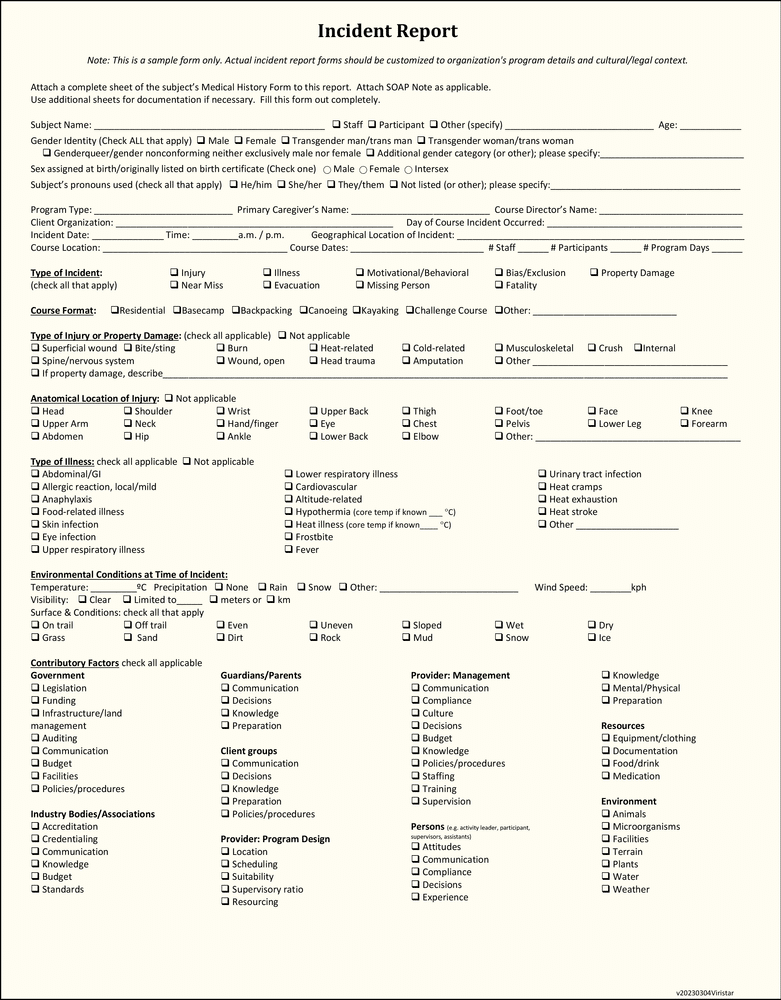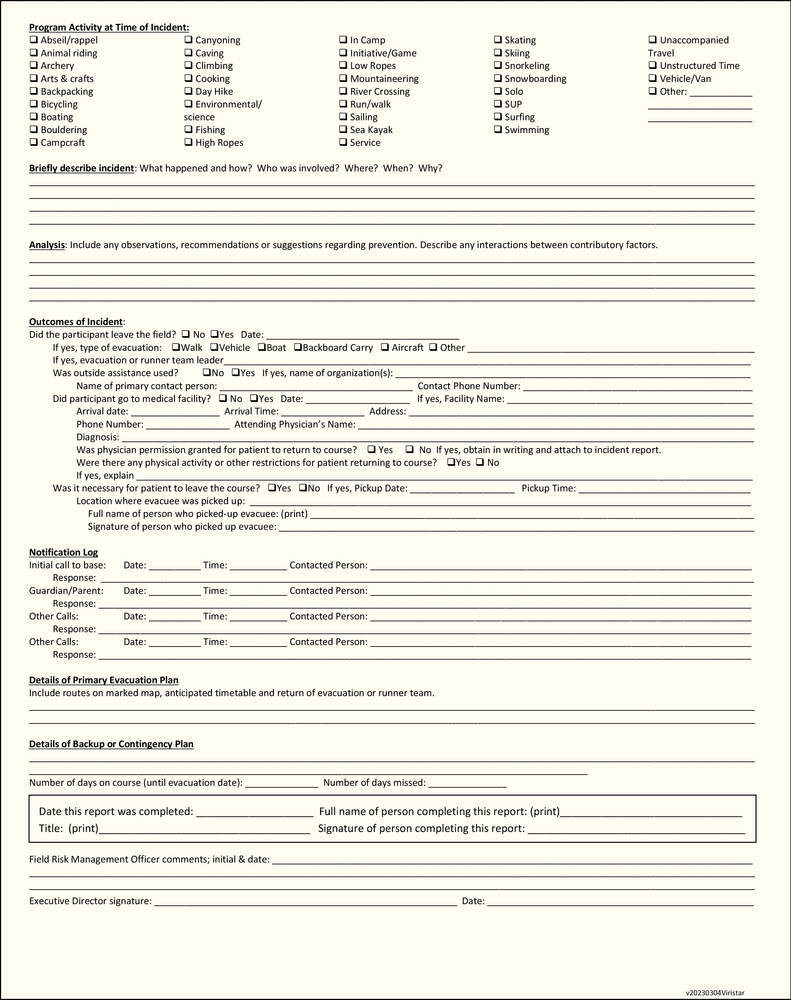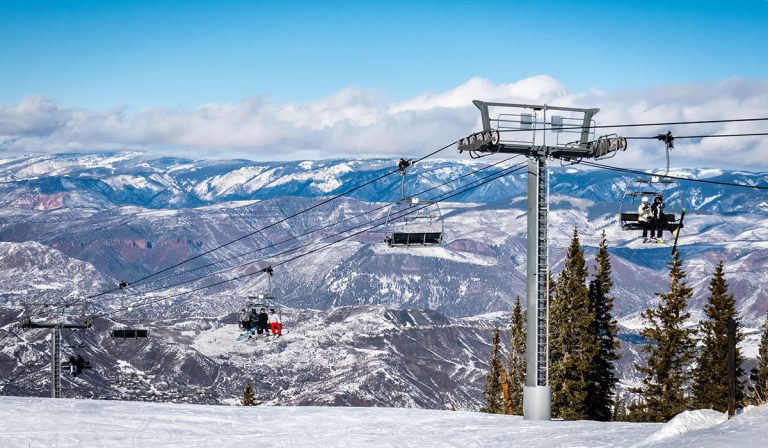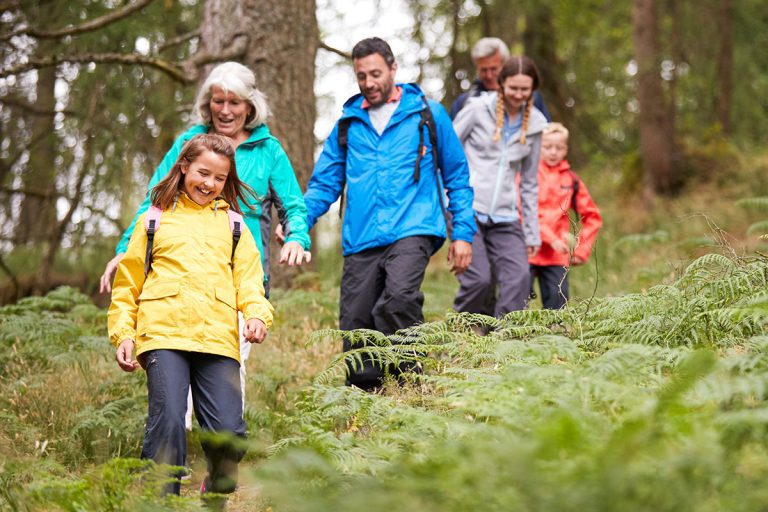Adaptations to Incident Report Forms Support Systems Thinking and Equity & Inclusion

As thinking evolves about how incidents occur, and the types of incidents that should be reported, incident reporting evolve too.
A new version of a standard incident report used in outdoor, experiential, wilderness, travel and adventure programs aims both to incorporate systems thinking and also to support equity and inclusion in outdoor programs.
Systems Thinking in Incident Reporting
Research tells us that if we wish to prevent incidents from occurring, or reduce their impacts then they happen, we need to look at the entire system that leads to mishaps.
This system involves people and things—equipment, technologies, the natural environment. It’s therefore referred to as a “sociotechnical system.” And because the many elements of the system change and interact in ways we can’t always predict, it’s considered a complex system.
The approach to trying to understand incident causation through this lens is called “complex sociotechnical systems theory.”
Contributing factors to an incident can spring from multiple sources:
- Government
- Outdoor industry associations
- Guardians/parents
- Client groups
- Providers
- Specific persons
- Resources
- The natural environment
Therefore, an incident reporting system that seeks to understand all the elements that led to a mishap should document the factors that spring from all of those sources.
That way, efforts to prevent recurrences can be directed at shifting government policy, improving the services (like training standards) offered by outdoor industry associations, and so on.
Incorporating Equity and Inclusion in Incident Reporting
Incident reports historically focused on documenting physical injuries, as well as illnesses and property damage.
A growing awareness about the importance of psychological safety, and the value of equity and inclusion in the led outdoor activity sector, encourages us to record incidents of bias and other forms of inequity and exclusion.
Gender-Inclusive Practice
Another part of supporting inclusion in how we interact with each other is recognizing the diversity of gender identities that exist. Understanding that the sex that may be listed on one’s birth certificate is different from one’s gender identity is important as well.
This incident report asks about gender identity, and gives multiple options:
Gender Identity (Check ALL that apply)
- Male
- Female
- Transgender man/trans man
- Transgender woman/trans woman
- Genderqueer/gender nonconforming neither exclusively male nor female
- Additional gender category (or other); please specify:______________________
The report also asks about sex assigned at birth:
Sex assigned at birth/originally listed on birth certificate (Check one)
- Male
- Female
- Intersex
And the form asks about a person’s pronouns:
Subject’s pronouns used (Check all that apply)
- He/him
- She/her
- They/them
- Not listed (or other); please specify:______________________
These practices follow guidance from the USA’s Centers for Disease Control and Prevention on collecting sexual orientation and gender identity information, as well as from the National LGBT Health Education Center, the Human Rights Campaign Foundation, and others.
It’s not necessary to collect all this data for every type of incident. However, in some cases, where health care is part of incident response, this information can help ensure that appropriate health care services are provided.
A More Holistic Incident Report Form
A new version of a two-page incident report is shown below. This form has a specific category of incident called “Bias/Exclusion.” Individuals filling out the report can check the “Bias/Exclusion” box, and then in the narrative section, describe in detail the incident involving inappropriate discrimination or inequity. Fields for gender identity, sex assigned at birth and pronouns are also included.
The form also has a section called “Contributing Factors” that lists factors in categories such as government, industry associations, and program design.
There are a number of well-developed online incident reporting systems, available in different geographies and at no cost or for a fee, that provide similar systems-informed reporting categories. And many health care systems and other institutions are incorporating gender-inclusive practices in their health forms, documents, or patient care.


More Than A New Report Form
It takes more than an updated Incident Report form to effectively address incidents of bias or exclusion on an outdoor or experiential program.
Incorporating complex sociotechnical systems theory into an organization’s safety management system or risk management plan also takes time, training and effort.
Individuals in the field who will be filling out these forms, and administrators who will receive the forms and follow up on their contents, need training in how to understand and approach bias/exclusion incidents, gender-inclusive practices, and systems-based safety thinking.
In some cases, considerable resistance to accepting these changes (particularly around equity, inclusion, sex and gender identity) may be encountered, and this should be factored in when weighing whether and how to introduce new practices.
And in many cases, operating procedures, training plans, and other aspects of an organization need to be adjusted to accommodate these considerations.
Limitations
There are several limitations to using this new incident report form.
- In some incidents, perhaps for instance minor property damage, collecting medical and related personal information on individuals involved is not needed. In situations where medical care is part of the response, however, asking about gender identity and sex may be appropriate.
- In order for the form to be used appropriately, training on those who fill out the form, and those who receive and process it, must be delivered.
- In some contexts, such as jurisdictions around the world where individuals face discrimination, criminal prosecution or serious bodily safety concerns due to issues of gender identity or other characteristics, it may not always be safe to acknowledge these characteristics. Incident report forms in those regions may even be best to omit specific questions where providing honest answers can lead to serious safety concerns.
- Issues of inclusion and systems thinking are evolving. There are many ways to frame these considerations, and there is no universally recognized best example. Organizations should select the incident form language and procedures that work best for their unique circumstances.
- Some organizations which use a SOAP Note or other form to document medical incidents may wish to include questions of gender identity or sex assigned at birth on that medical-specific form rather than on a generic incident report.
- This template incident report form can also be customized to individual circumstances with regards to terminology (the terms “course,” “client,” “course director” and “field risk management officer,” for example, may not be relevant to all organizations). Course format fields, environmental conditions options, and program activities can all be customized. For instance, organizations engaged in foefie sliding, kloofing, zorbing, coasteering, or river sledding may wish to list those activities, but exclude skiing or fishing if those activities are not offered. Other customization options should be used as appropriate.
Conclusion
Incident reports have been used for many years to help us understand why incidents occur, and how future mishaps might be mitigated or prevented. Incident report form variations abound, and are constantly evolving.
Including a specific section to record bias/exclusion incidents can help raise awareness of these types of incidents involving psychological safety, and can improve mental health and wellness.
Gathering about gender identity, sex assigned at birth and pronoun use, when relevant, can support inclusive health care and improve psychological and physical health and well-being outcomes.
Gathering data about contributing factors from throughout the entire complex sociotechnical system of led outdoor activities can effectively help improve risk management practices and safety outcomes across the entire sector.
The ideas discussed here are but one of many potential ways to advance incident reporting. Organizations should consider their unique circumstances and determine what steps are best for their situation.



